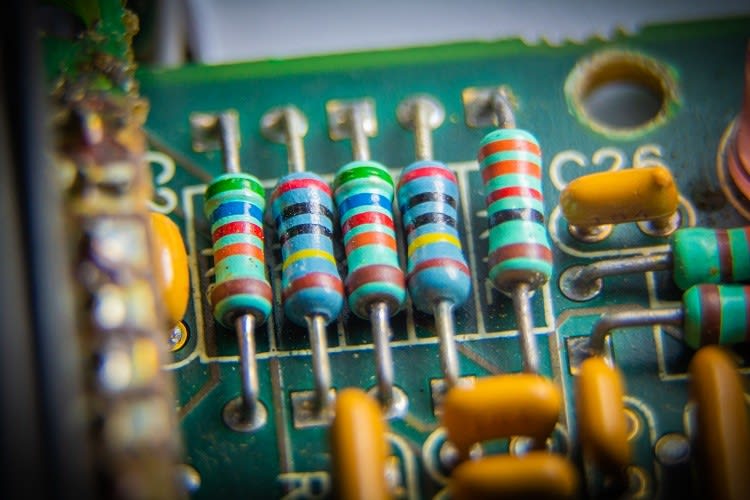Resistors - What Are They Good For?
Follow articleHow do you feel about this article? Help us to provide better content for you.
Thank you! Your feedback has been received.
There was a problem submitting your feedback, please try again later.
What do you think of this article?
When was the last time you thought about resistors? Most of us can probably remember science lessons in High School, creating simple electrical circuits. In these experiments, we used resistors to control the flow of energy around the circuit - they made the light bulb dimmer.
This is possibly the last time that you paid much attention to resistors. They are just about the simplest of all components used in electronic design, even more so than inductors or capacitors. In their basic form, resistors are little more than conductors that impede the flow of electricity. For this reason, resistors could be the most neglected of all electrical components.
However, the resistor, in all its forms, is very versatile and has led me to ask the question “when is a resistor more than just a resistor?”
The Classic
For many of us, the image at the top of the page is what springs to mind when we think of resistors. They are found on almost every printed circuit board (PCB) in the world, even though the modern dominance of surface mount technology means that today’s resistors are little more than rectangular chips.
Regardless of their form, resistors perform a number of tasks on the PCB. They are used to split voltage and they are used to balance circuits. They are used to control the amount of energy that flows around the board.
This sounds simple, and it is. The variety comes when we are forced to choose the right product. For example, chip resistors are available in thin-film or thick-film varieties. The differences are not obvious at first glance – both types are available in standard surface-mount package sizes. What separates them is the construction method used. The result is a compromise between power and precision. The greater mass of thick-film resistors makes them suitable for use with higher power ratings, but their construction prevents precision in the exact resistance value.
In contrast, the manufacturing process of the thin-film resistor allows much greater precision at the cost of a lower power rating. This precision is vital in certain applications including medical equipment or weighing equipment. New developments in materials and techniques are blurring the lines between power and precision, such as the MCW Series from Vishay (205-6956) , giving the engineer greater choice. However, if we need to handle serious power, we need to look at other technologies
The Heavyweight
While small chip resistors are ideal for the fine-tuning of electrical circuits, to handle high power we need to move away from the printed circuit board. Large power resistors are the heavyweights of the electronics world. They are engineered to handle large amounts of excess energy and dissipate it safely.
These power resistors use much more robust construction methods, consisting of coils of wire wrapped around a ceramic core, and housed in an aluminium heatsink to dissipate heat. The wirewound resistor may look like a product from a bygone era, but it still has a key role to play today. In fact, some of the latest trends are giving the power resistor a new lease of life, from electricity microgeneration to electric vehicles.
Electric vehicles use huge batteries that deliver power to the motors. The current and voltage ratings involved are high, and the danger to the mechanic who must service an electric car is high. They need some way to safely discharge the battery, and this is an ideal application for the wirewound resistor.
In this instance, we could consider these wirewound monsters not as resistors in the traditional sense, but rather as energy management devices. Products like the Arcol HSW600 series (252-3016) are designed to dissipate up to 600 Watts of power, and even feature water cooling to help with the task of thermal management.
The Safeguard
The humble resistor can become an important safety device. While the move to surface mounting technology seems relentless, there are still applications where a through-hole resistor can be especially useful.
The quest for safety can take different paths. For some products, safety means being able to absorb a large pulse or surge of power without causing damage to the sensitive electronics inside. For other products, it is important to allow the safe dissipation of energy away from other components that may be heat-sensitive.
In these applications, resistors like the SQ series from TE Connectivity (137-2755) can be used. Their ceramic and cement construction allows them to dissipate a large amount of energy, and they can be safely used inside electronic equipment. This type of product offers engineers an alternative to traditional fuses or circuit breakers as safety devices.
Re-think Your Resistor
We have only really scratched the surface of resistor technology. Far from being the long-neglected component of the electronics industry, they represent a versatile addition to the engineer’s toolkit. They can be energy regulators, thermal management devices or even alternatives to circuit breakers. Next time you need to solve a problem in your product design, think about what a resistor might be good for…



